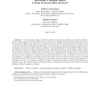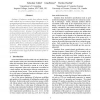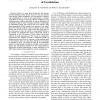10 search results - page 2 / 2 » Towards safety guarantees for service-oriented systems |
AR
2004
13 years 5 months ago
2004
-- An inevitable collision state for a robotic system can be defined as a state for which, no matter what the future trajectory followed by the system is, a collision with an obsta...
ICSE
2007
IEEE-ACM
14 years 5 months ago
2007
IEEE-ACM
Synthesis of behaviour models from software development artifacts such as scenario-based descriptions or requirements specifications not only helps significantly reduce the effort...
IROS
2008
IEEE
13 years 11 months ago
2008
IEEE
— There is a great effort during the last decades towards building robotic devices that are worn by humans. These devices, called exoskeletons, are used mainly for support and re...
ICRA
2005
IEEE
13 years 11 months ago
2005
IEEE
— A new distributed coordination algorithm for multi-vehicle systems is presented in this paper. The algorithm combines a particular choice of navigation function with Voronoi pa...
ICFP
2005
ACM
14 years 5 months ago
2005
ACM
Proof-carrying code (PCC) is a general framework that can, in principle, verify safety properties of arbitrary machine-language programs. Existing PCC systems and typed assembly l...



